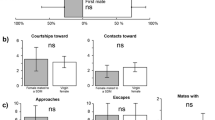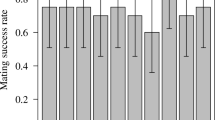Summary
The influence of the female on the process of sperm storage and use was examined. Copula duration, the condition of the female and whether or not a copula terminated naturally influenced the number of spermathecae (of three) in which once-mated females stored sperm. Females stored more sperm the larger their mate and the sperm from larger males were stored more unevenly amongst the spermathecae than were those from smaller males. Double-mated females had sperm in fewer spermathecae the larger the second of their mates and these spermathecae tended to be the ones which lay together within the female. The P2 values over three successive clutches were constant and sperm precedence was complete when the larger male was second to mate but began low and increased over subsequent clutches when the smaller male mated second. These results suggest females prefer, and are able, to use the sperm of larger males to fertilise their eggs. It is proposed that multiple spermathecae in Diptera have evolved to give females better control over offspring paternity.
Similar content being viewed by others
References
Borgia G (1979) Sexual selection and the evolution of mating systems. In: Blum MS, Blum NA (eds) Sexual selection and reproductive competition in insects. Academic, New York, pp 19–80
Birkhead TR, Hunter FM (1990) Mechanisms of sperm competition. Trends Ecol Evol 5:48–52
Eberhard WG (1985) Sexual selection and animal genitalia. Harvard UP, Harvard
Eberhard WG (1990) Inadvertant machismo? Trends Ecol Evol 5:263
Harris H, Hopkinson DA (1978) Handbook of enzyme electrophoresis in human genetics. North-Holland Publishing, Amsterdam
Kloet GS, Hincks WD (1975) A check list of British insects. Royal Entomological Society, London
Knowlton N, Greenwell SR (1984) Male sperm competition avoidance mechanisms: the influence of female interests. In: Smith RL (ed) Sperm competition and the evolution of animal mating systems. Academic, New York, pp 61–84
Matsuda R (1976) Morphology and evolution of the insect abdomen. Pergamon, Oxford
Otronen M, Siva-Jothy MT (1991) The effects of postcopulatory male behaviour on ejaculate distribution within the female sperm storage organs of the fly, Dryomyza anilis (Diptera: Dryomyzidae). Behav Ecol Sociobiol 29:33–37
Parker GA (1970a) Sperm competition and its evolutionary consequences in the insects. Biol Rev Cambridge Phil Soc 45: 525–567
Parker GA (1970b) Sperm competition and its evolutionary effect on copula duration in the fly Scatophaga stercoraria. J Insect Physiol 16:1301–1328
Parker GA (1978) Searching for mates. In: Krebs JR, Davies NB (eds) Behavioural ecology, 1st edn. Blackwell, Oxford, pp 214–244
Parker GA (1979) Sexual selection and sexual conflict. In: Blum MS, Blum NA (eds) Sexual selection and reproductive competition in insects. Academic, New York, pp 123–166
Parker GA (1984) Sperm competition and the evolution of animal mating strategies. In: Smith RL (ed) Sperm competition and the evolution of animal mating systems. Academic, New York, pp 1–60
Parker GA (1992) Marginal value theorem with exploitation time costs: diet, sperm, and optimal copula duration in dung flies. Am Nat 139:1237–1256
Parker GA, Simmons LW (1991) A model of constant random sperm displacement during mating: evidence from Scatophaga. Proc R Soc London B 246:107–115
Parker GA, Simmons LW, Kirk H (1990) Analysing sperm competition data: simple models for predicting mechanisms. Behav Ecol Sociobiol 27:55–65
Parker GA, Simmons LW, Ward PI (1993) Optimal copula duration in dungflies: effects of frequency dependence and female mating status. Behav Ecol Sociobiol 32:157–166
Ridley M (1989) The incidence of sperm displacement in insects: four conjectures, one corroboration. Biol J Linn Soc 38:349–367
Sigurjonsdottir H, Parker GA (1980) Dung fly struggles: evidence for assessment strategy. Behav Ecol Sociobiol 8:219–230
Simmons LW, Parker GA (1992) Individual variation in sperm competition success of yellow dung flies, Scatophaga stercoraria. Evolution 46:366–375
Simmons LW, Ward PI (1991) The heritability of sexually dimorphic traits in the yellow dung fly Scathophaga stercoraria (L.). J Evol Biol 4:593–601
Smith RL (ed) (1984) Sperm competition and the evolution of animal mating systems. Academic, New York
Sokal RR, Rohlf FJ (1981) Biometry, 2nd edn. Freeman, San Francisco
Ward PI, Simmons LW (1991) Copula duration and testes size in the yellow dung fly, Scathophaga stercoraria (L.): the effects of diet, body size, and mating history. Behav Ecol Sociobiol 29:77–85
Author information
Authors and Affiliations
Rights and permissions
About this article
Cite this article
Ward, P.I. Females influence sperm storage and use in the yellow dung fly Scathophaga stercoraria (L.). Behav Ecol Sociobiol 32, 313–319 (1993). https://doi.org/10.1007/BF00183786
Received:
Accepted:
Issue Date:
DOI: https://doi.org/10.1007/BF00183786




